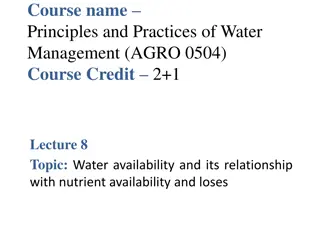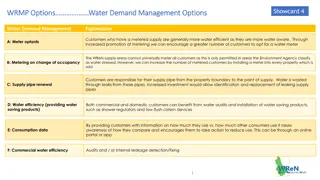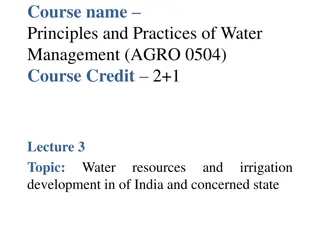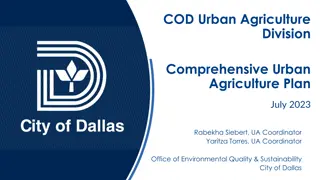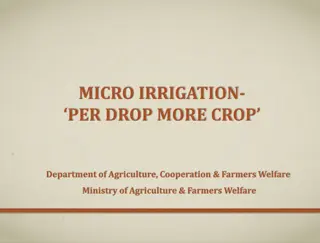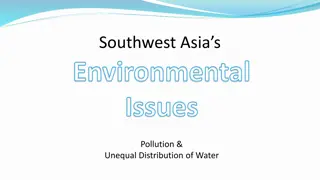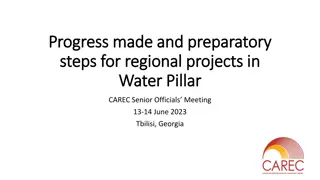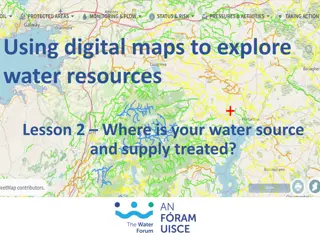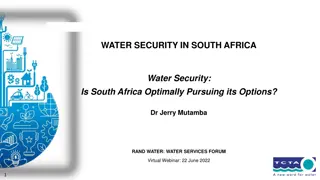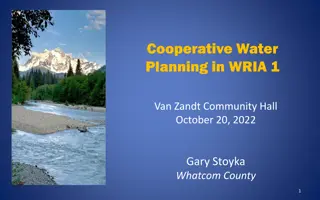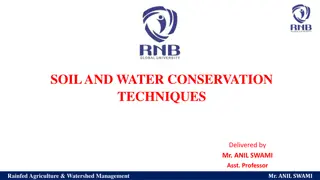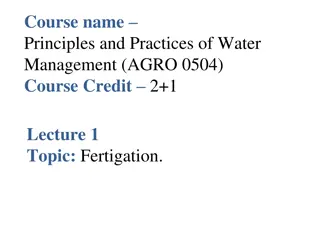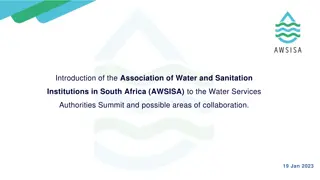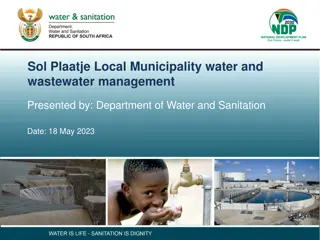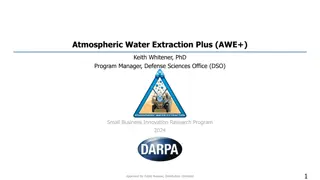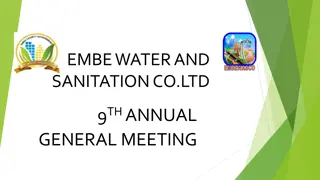Understanding Principles and Practices of Water Management in Agriculture
This course delves into the field water cycle, water movement in soil and plants, soil-plant-water relationships, water dynamics in the soil-plant-atmosphere system, soil composition, soil texture classification, permeability factors, density of soil solids, total porosity assessment, and energy aspects related to water movement. It covers essential topics for managing water effectively for agricultural purposes.
Download Presentation

Please find below an Image/Link to download the presentation.
The content on the website is provided AS IS for your information and personal use only. It may not be sold, licensed, or shared on other websites without obtaining consent from the author. Download presentation by click this link. If you encounter any issues during the download, it is possible that the publisher has removed the file from their server.
E N D
Presentation Transcript
Course name Principles and Practices of Water Management (AGRO 0504) Course Credit 2+1 Lecture 4 Topic: Field water cycle, water movement in soil and plants.
UNIT II Soil- Plant- Water Relationships
Water in the Soil-Plant- Atmosphere System Soil Moisture Plant Uptake Translocation Evapotranspiration Infiltration Redistribution Withdrawal Passive absorption Active absorption Aerial absorption
Soil A three phase disperse system The soil is a heterogeneous, polyphasic viz., solid, liquid and gaseous and porous system Volume composition & sectional view of soil
Soil texture Very Coarse sand Size grouping in diameter(USDA) 2.0 1 mm ISSS Coarse sand 1.0 0.5 mm 2-0.2 medium sand 0.5 0.25 mm Fine sand 0.25 0.10 mm 0.2-0.02 Very Fine sand 0.10 0.05 mm Silt 0.05 0.002 mm 0.02-0.002 Clay < 0.002 mm <0.002 Size groupings of soil particles
Effect of structural type on permeability for water
Density of soil solids Particle density ( d): It is the ratio of a given mass (or weight) of soil solids to that of its volume. It is usually expressed in terms of g/cm3. Bulk density (bd): It refers to the ratio of a given mass of an oven dried soil to that of its field volume (i.e., solids + pore spaces).
Pore space Soil total porosity A is an index of pore volume in the soil. It is the space in a givenvolume of soil that is occupied by air and water or not occupied by the soil solids. The total porosity is calculated as follows Total porosity value generally lies in the range of 30 to 60% for arable soils. Coarse textured soils tend to be less porous (35 50%) than the fine textured soils (40 60%),though the mean size of individual pores is greater (>0.06mm in diameter) in the former than in the latter. Soil moisture tension: The moisture held in the soil against gravity may be described in terms of moisture tension.
ENERGY MOVING WATER Kinetic Energy: when water (not soil water) is flowing in a river in rapid and turbulent flows. Potential Energy: determines the status and movement of soil water (moving very slowly). Like all substances, soil water move from higher to lower energy level.
In woody perennials, when phloem tissue is severed by girdling: 1. The tissue above the cut proliferates 2. The tissue below the cut is starved photosynthates (Fig. 12-12). This can severely stunt and even kill a tree The rate of translocation of sugars in the phloem is, in some instances, more than a thousand times faster than simple diffusion of sugar through water. The forces that create these high rates of movement are called active transport.
TWO DIMENTIONAL STRUCTURE OF WATER MOLECULE (The Nature and Properties of Soils, 14th Edition, revised)
HYDROGEN BONDING (The Nature and Properties of Soils, 14th Edition, revised)
pF In attempting to express the matric potential (or soil moisture tnsion) of soil water in terms of an equivalent hydraulic head (or energy per unit weight), it is understood that this head may be of the order of 100 cm or even 100000 cm of water. To avoid the use of such cumbersomely large numbers, Schofield (1935) suggested the use of pF (by anology with the pH acidity scale), which is defined as the logarithm of the negative pressure (soil water tension or suction) head in cm of water. A tension of 10 cm of water is, thus, equal to a pF of 1. Likewise, a tension head of 1000 cm is equal to a pF of 3, and so forth. Approximate equivalents among expressions of soil water tension are given below in Table
Approximate equivalents among expressions of soil water tension
OSMOTIC EFFECT Cell plasma Cell plasma Saline soil solution Non-saline soil solution Water Water Cell wall Cell wall A B
Available water (AW) is defined as the soil moisture between field capacity (FC) and the permanent wilting point (PWP): AW = FC - PWP Water between FC and saturation is not considered available because it is lost through drainage. Water at tensions greater than PWP is held too tightly by the soil for plants to remove.
Soil Water Potential The SWP potential is defined as the potential energy of water in soil. The SWP is quantified relative to a standard state where water has no solutes, free from external forces except gravity, at a reference pressure, at a reference temperature and at a reference elevation . The SWP is then defined as the energy state of water in soil with respect to the energy of water at the reference state. The total SWP ( t ) is determined by a variety of forces acting on the soil water, including gravitational ( g ), matric (capillary and adsorptive, m ), osmotic ( o ) and hydrostatic ( h ). t = g + m + o + h
Soil-Plant-Atmosphere Continuum The movement of water from the soil, into the roots, through the xylem and from the leaf into the atmosphere, occurs because of a series of water potential gradients. The system that involves the soil, the plant s roots, the xylem, the leaf and the atmosphere, is called the soil-plant-atmosphere continuum (SPAC)
Physical Classification of Water 1.Gravitational water Water held between 0.0 to 0.33 bars (0 to 33 kPa) soil moisture tension, free and in excess of field capacity, which moves rapidly down towards the water table under the influence of gravity is termed as gravitational water 2. Capillary water As the name suggests capillary water is held in the pores of capillary size i.e., micro pores around the soil particles by adhesion (attraction of water molecules for soil particles), cohesion (attraction between water molecules) and surface tension phenomena.It includes available form of liquid water extracted by growing plants and is held between field capacity (0.33 bars or 33 kPa) and hygroscopic coefficient (31 bars or 3100 kPa)
However, the water within the capillary range is not equally available i.e., it is readily available starting from 0.33 bars up to a certain point often referred to as critical soil moisture level (for most crops it varies between 20 to 50% depletion of available soil moisture) and thereafter up to 15 bars ( 1500 kPa) it is slowly available. Further below, when the soil exerts tensions between 15 bars and 31 bars, the water is held very tightly in thin films and is practically not available for plant use. The capillary water moves in any direction but always in the direction of increasing tension and decreasing potential. 3.Hygroscopic water The water held tightly in thin films of 4 5 milli microns thickness on the surface of soil colloidal particles at 31 bars tension ( 3100 kPa) and above is termed as hygroscopic water (Fig. 8.1). It is essentially non-liquid and moves primarily in vapour form. Plants cannot absorb such water because, it is held very tenaciously by the soil particles (i.e., > 31 bars). However, some microorganisms may utilize it. Unlike capillary water which evaporates easily at atmospheric temperatures (i.e., it requires very little energy for its removal), hygroscopic water cannot be separated from the soil unless it is heated at 100 C and above for 24 hours.
LEVELS OF SOIL MOISTURE Saturation: Almost all of the pores filled with water with no air. Generally happens right after heavy rainfall / snow melt or application of flood irrigation. Field Capacity: Excessive moisture drained with gravitational force, mostly out of macro-pores. Medium and small pores will still be filled with water held due to adhesion and cohesion. Depending on the soil type, happens between 1 to 3 days after a heavy rainfall.
LEVELS OF SOIL MOISTURE Permanent Wilting Point: Not enough available moisture for normal plant growth. Continuous unavailability causes plant wilting and ultimately death. Hygroscopic Moisture Level: Soil is air dry with no availability of moisture for plants.
PLANT AVAILABLE WATER Water holding capacity: Amount of soil water held between field capacity and permanent wilting point. Plant available water: Portion of water holding capacity that can be absorbed by the plants. As a general rule, plant available water is considered to be 50 percent of the water holding capacity.
TYPES OF SOIL WATER Gravitational Water: Free water Macro-pores Moves rapidly under good soil drainage conditions Is not available to plants Under poor soil drainage conditions, cause plant wilting due to lack of soil oxygen Courtesy of F. Casey
GRAVITATIONAL WATER Under good soil drainage: Leaches excessive salts Oxygen Under poor soil drainage: High groundwater levels Lack of soil oxygen Buildup of excessive salts How do you improve conditions? Build aggregates Rooting channels Reduce compaction Use water with crops Subsurface and Surface drainage
TYPES OF SOIL WATER Capillary Water: Plant available water Tension Adhesion (attraction to soil) Cohesion (attraction to water) Evaporation Courtesy of F. Casey
CAPILLARY RISE Can move to any direction from wet areas (low soil moisture tension) to dry area (high soil moisture tension).
CAPILLARY RISE Under good soil drainage: Movement remains restricted below the rooting zone of most of the crops, due to low groundwater levels No buildup of excessive salts Under poor soil drainage: Excessive buildup of salts Poor growth environment
SOIL WATER MOVEMENT FACTS Plant available water is between FC and PWP moisture levels. Gravitational water is excess water. Gravitational forces cause the downward movement of soil water under good soil drainage conditions. Slow or poor movement of gravitational water will cause saturated conditions, high groundwater levels and surface runoff. Subsurface drainage system will only collect gravitational water.
SOIL WATER MOVEMENT FACTS Soil water moves quickly through the larger pores, as it is held more tightly in the smaller pores. Water will not move from the smaller pores to larger pores unless conditions are saturated. Tortuosity of the soil pores also restricts the soil water movement. Water moving along the pore walls versus center will move slowly. Adhesion and cohesion forces cause the capillary soil water movement/rise. High groundwater levels combined with soil surface evaporation will maximize capillary rise. Capillary rise will be maximized for heavier soils. Preserving top soil moisture will minimize capillary rise.
Water movement in Soil Water movement in soil occurs in three distinct ways: 1. Saturated flow 2. Un-saturated flow 3. Vapour movement
(i) Saturated flow This occurs when the soil pores are completely filled with water. This water moves at water potentials larger than 33 kPa. Saturated flow is water flow caused by gravity s pull. It begins with infiltration, which is water movement into soil when rain or irrigation water is on the soil surface. When the soil profile is wetted, the movement of more water flowing through the wetted soil is termed percolation. Hydraulic conductivity can be expressed mathematically as V = kf Where, V = Total volume of water moved per unit time f = Water moving force k = Hydraulic conductivity of soil
Hydraulic conductivity: The hydraulic conductivity of a soil is a measure of the soil's ability to transmit water when submitted to a hydraulic gradient. Hydraulic conductivity is defined by Darcy's law, which, for one-dimensional vertical flow, can be written as follows: h1- h2 V= K L Where, V is Darcy's velocity (or the average velocity of the soil fluid through a geometric cross-sectional area within the soil), h1 and h2 are hydraulic heads, and L is the vertical distance in the soil through which flow takes place. The coefficient of proportionality, K, in the equation is called the hydraulic conductivity.
(ii) Unsaturated Flow It is flow of water held with water potentials lower than- 1/3 bar. Water will move toward the region of lower potential (towards the greater pulling force). In a uniform soil this means that water moves from wetter to drier areas. The water movement may be in any direction .The rate of flow is greater as the water potential gradient (the difference in potential between wet and dry) increases and as the size of water filled pores also increases. The two forces responsible for this movement are the attraction of soil solids for water (adhesion) and capillarity. Under field conditions this movement occurs when the soil macropores (noncapillary) pores with filled with air and the micropores (capillary) pores with water and partly with air.
(iii) Water Vapour Movement The movement of water vapour from soils takes place in two ways: (a)Internal movement the change from the liquid to the vapour state takes place within the soil, that is, in the soil pores (b) External movement the phenomenon occurs at the land surface and the resulting vapour is lost to the atmosphere by diffusion and convection. The movement of water vapour through the diffusion mechanism taken place from one area to other soil area depending on the vapour pressure gradient (moving force).This gradient is simply the difference in vapour pressure of two points a unit distance apart. The greater this difference, the more rapid the diffusion and the greater is the transfer of water vapour during a unit period.
Hysterisis The moisture content at different tensions during wetting of soil varies from the moisture content at same tensions during drying. This effect is called as hysterisis. This is due to the presence of capillary and non capillary pores. The moisture content is always low during sorption and high during desorption. Hystersis phenomenon exists in soil minerals as a consequence of shrinking and swelling. Shrinking and swelling affect pore size on a microbasis as well as on the basis of overall bulk density. So, hystersis phenomenon occurs due to factors like shape and size of soil pores and their interconnection with each other pore configuration, nature of soil colloids bulk density of soil and entrapped air. The most important factor affecting hystersis is the entrapment of air in the soil under rewetting condition. This clogs some pores and prevent effective contact between others.
Direct methods 1 Gravimetric method The gravimetric method is a direct measurement of soil water content and is therefore the standard method by which all indirect methods are calibrated. The gravimetric water content, also called mass water content, is the ratio of the weight loss in drying to the dry weight of the soil sample. The mass water content can be expressed as mass water percentage by multiplying it with 100 ( m).
2 Volumetric method The volumetric water content ( v) is defined as the volume of water present in agiven volume (usually 1 m3) of dry soil. When ( v) multiplied by 100 it gives volume water percentage.
Merits Ease of handling Low cost Minimum technical skill required Standard method of soil moisture determination with which other methods are Compared Demerits Time consuming Accuracy is subject to weighing and sampling errors Destructive soil sampling method Laborious
3 Spirit burning method Soil moisture from the sample is evaporated by adding alcohol and iginiting. Provided the sample is not too large, the result can be obtained in less than 10 minutes. About 1.0 ml of spirit or alcohol per g of soil sample at field capacity and 0.5 ml at permanent wilting point is adequate for evaporating the soil moisture. This method is not recommended for soils with high organic matter content. 4 Infrared moisture balance It consists of a 250 watt infrared lamp, sensitive torsion balance and autotransformer (Fig. 10.1). All housed in an aluminium cabinet. The radiation emitted by infrared lamp quickly vaporizes the soil moisture. The instrument is directly calibrated in per cent moisture. It gives fairly reliable moisture estimates in about 5 minutes.
Indirect methods 1 Electrical resistance blocks Gypsum blocks or electrical resistance blocks, with two electrodes, is placed at a desired soil depth and allowed to equilibrate (Fig. 10.2). Electrical resistance of the block is measured by a meter based on the principal of Whetstone Bridge. Electrical resistance of the soil decreases with increase in water content. Soil water content is obtained with calibration curve, for the same block, of electrical resistance against known soil water content. Resistance blocks read low resistance (400 600 ohms) at field capacity and high resistance (50,000 to 75,000 ohms) at wilting point.
Merits Relatively inexpensive Easy to install Gives quick readings Suitable for irrigation scheduling to crops raised in fine textured soils Demerits Not useful in coarse textured soils Resistance blocks readings are sensitive to soil salinity, which may affect readings Blocks may get damaged over time (2 3 years) and require replacement


